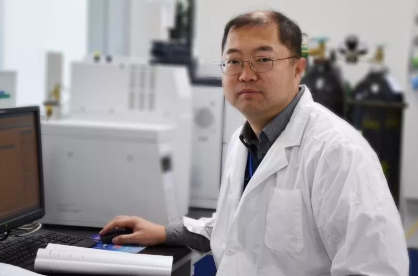Overseas returnee helps cataract suffuerers in China
 |
|
Xie Jiangbing, born in 1972, is the chairman and general manager of Eyebright (Beijing) Medical Technology Company. [Photo provided to chinadaily.com.n] |
Treat cataracts for more Chinese people
The lens in the human eye is equivalent to that of the camera, but as people grow old, it may become blurred until the light cannot reach the eye, and a cataract will form.
In the history of treating cataracts there was a needle-splitting treatment in ancient China which required the doctor to put a hole in the lens and let a little light leak into the eye. But nowadays, with artificial lens, patients can regain vision by having the eye's original lens replaced.
After graduating from the University of California in Davis, Xie entered Abbott Laboratories, a Fortune 500 company. After working his way up for seven years from a researcher to a chief scientist, a news release from the World Health Organization attracted his attention and eventually changed his life path.
Xie can still remember the data. In terms of the number of cataract surgeries performed per million, the United States exceeded 8,000, India surpassed 6,000, Vietnam reached 2,000, and China stood at just 1,000, far behind other countries.
Why, Xie wondered, is it so difficult to perform a cataract surgery in China? He went back to China to look for an answer, and found that in addition to the unbalanced allocation of medical resources, the more important reason is that the intraocular lens (IOL) was monopolized by foreign countries.
The high-end lens cost nearly 10,000 yuan per piece. The expensive price blocked the recovery roads for many patients.
Meanwhile, American companies were very mature in the production of IOL, with 1,579 patents directly related to products. Under these patent barriers, it was difficult for domestic companies to manufacture their own products, and hospitals had to buy foreign products.
The number of patients in need of cataract surgery China had reached 5 million, with over 400,000 people added every year. This made the IOL the most important and most beneficial biological item in the field of ophthalmology.
The monopoly of the market and technology not only caused economic burdens for patients, but also pushed up the expenditures for national procurement.
As a doctor and scientist in material science, Xie feel distressed that he couldn't use his knowledge to contribute to the country. Therefore, he vowed to use what he had learned to change this situation, break foreign technical barriers, and develop IOL Chinese brands.
Thus, in 2010, Xie made the decision to return to China.
Back to China at the right time
Xie chose to start up business in Zhongguancun Changping Park, for it had the mature business supporting policies of Beijing and Zhongguancun, and had gathered a group of medical technology enterprises.
The research, development and production of IOLs have high precision demands, so the foundation of the workshop had to be very stable; only factories without a basement could meet the requirements. The science park helped him to select workshops until he found a qualified one.
The development of medical devices in China requires a long process of research and development, clinical validation and approval, and also needs a large amount of capital investment.
Xie received venture capital support of 50,000 yuan and 200,000 yuan in 2011 and 2012 respectively. For a startup company run by an overseas returnee, these supports were necessary as angel investments.
Xie often tell others that he was not among the first group that returned to China, but he came back at the right time. In March 2011, the state issued the "Opinions on the Construction of Talent Zones in Zhongguancun National Independent Innovation Demonstration Zone".
At that time, the returned entrepreneurial talents in Zhongguancun exceeded 15,000, and had founded over 6,000 companies. Returnee entrepreneurship had entered the golden age.
In 2012, Xie was made an exception and was rated as a professor-level senior engineer. The qualifications and honors given to him by the government served as an endorsement of his company.
Eyebright put much effort into research and working towards scientific breakthroughs in the early stage, until its first product received a registration certificate four years later.
During the four years, the company received government-funded equity financial support of 6 million yuan. In addition, it received financing guarantees and loan interest subsidies provided by Zhongguancun for returned overseas talents.
